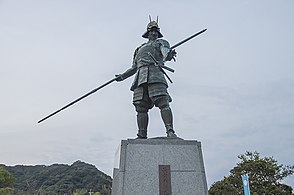Kōchi (city)
Kōchi
高知市 | |||||||||||||
|---|---|---|---|---|---|---|---|---|---|---|---|---|---|
| Kōchi City | |||||||||||||
 From top left: Katsurahama, Statue of Sakamoto Ryoma, View of Kōchi from Mt. Godai, Yosakoi Festival, Harimayabashi, Tosa Electric Railway, Kōchi Castle | |||||||||||||
 Flag  Chapter | |||||||||||||
 Location of Kōchi in Kōchi Prefecture | |||||||||||||
 | |||||||||||||
 Kōchi Location in Japan | |||||||||||||
| Coordinates: 33°33′32″N 133°31′53″E / 33.55889°N 133.53139°ECoordinates: 33°33′32″N 133°31′53″E / 33.55889°N 133.53139°E | |||||||||||||
| Country | Japan | ||||||||||||
| Region | Shikoku | ||||||||||||
| Prefecture | Kōchi Prefecture | ||||||||||||
| Government | |||||||||||||
| • Mayor | Seiya Okazaki | ||||||||||||
| Area | |||||||||||||
| • Total | 309.22 km2 (119.39 sq mi) | ||||||||||||
| Population (April 1, 2017) | |||||||||||||
| • Total | 332,059 | ||||||||||||
| • Density | 1,100/km2 (2,800/sq mi) | ||||||||||||
| Time zone | UTC+09:00 (JST) | ||||||||||||
| City hall address | 5-1-45 Honmachi, Kōchi-shi 780-0571 | ||||||||||||
| Website | www | ||||||||||||
| |||||||||||||
| Kōchi | |||
|---|---|---|---|
| Japanese name | |||
| Kanji | 高知市 | ||
| Hiragana | こうちし | ||
| Katakana | コウチシ | ||
| |||
Kōchi (高知市, Kōchi-shi, pronounced [koːꜜtɕi ɕi]) is the capital city of Kōchi Prefecture located on the island of Shikoku in Japan. Kōchi is the main city of the prefecture with over 40% of its population.
Overview[]
A symbol of the city is its most famous dish, katsuo tataki, made by lightly searing and seasoning bonito.[2]
History[]
Feudal period[]
The river plain now containing the city centre was originally settled as a castle town around the seat of the lords of Tosa Province, Kōchi Castle. The castle site was chosen by Lord Yamauchi Kazutoyo in 1601. The city takes its name from that of the castle. As the centre of administration for the province, and the prefecture which succeeded it, the town rapidly grew to become the largest settlement of the region.
Meiji period[]
During the time of the Meiji Restoration, Kōchi became famous as a centre of pro-imperial ideology, and later for incubating democratic and human rights movements.
The city was incorporated on April 1, 1889.
Tram service began in the city on May 2, 1904, and the city was connected to the national rail network on November 12, 1951.
WWII air raid[]
Kōchi was selected as a target by the United States' XXI Bomber Command because of the city's status as a prefectural capital, and the fact that it was a center for industry and commercial trade. On July 3, 1945 at 6:22 PM (JST) 129 Aircraft took off to bomb Kōchi. 1060 tons of incendiary bombs were dropped on Kōchi, destroying 48% of the built up areas of the city.[3]
Modern period[]
On April 1, 1998, the city was designated as the first core city on Shikoku.
On January 1, 2005, the villages of Kagami and Tosayama, both from Tosa District were merged into Kōchi.
On January 1, 2008, the town of Haruno (from Agawa District) was also merged into Kōchi.
Geography[]

The area of Kōchi has three distinct geographic sections. The major settled part of the city lies at the head of , in a narrow alluvial plain crossed by several rivers, notably the and . The plain is bounded by mountains to the north and a range of hills to the south and west.
The northern mountains form the least densely populated part of the city, with the only settlement being along narrow river valleys. The highest point in Kōchi is Kuishi-yama at 1,176 metres (3,858 ft).
To the south of the city centre, Urado Bay cuts through the hills to its outlet into the Pacific Ocean. The land surrounding the bay and a small strip of the coastline form the third part of the city. This area, although hillier and less dense than the plain, is nevertheless a major location of housing and port-related industry.
Cityscape[]
- Gallery
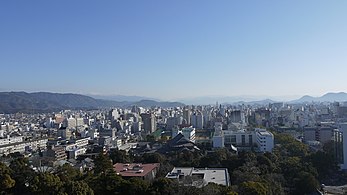
Central business district of KōchiCity(2013)
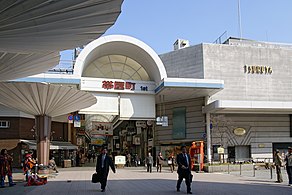
Obiyamachi in Downtown KōchiCity(2008)
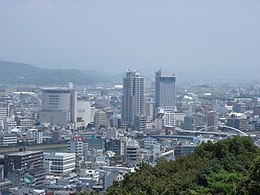
Skyline of KōchiCity(2006)
Climate[]
Kōchi has a very wet humid subtropical climate (Köppen climate classification Cfa), receiving twice as much rainfall as Shikoku's other chief cities Matsuyama and Takamatsu. It is also the most typhoon-prone of Japan's major cities owing to its location directly exposed to the open Pacific Ocean from which the storms enter the country, and has twice received over 50 cm (20 in) of rainfall in a day from a typhoon.
| hideClimate data for Kochi (1991−2020 normals, extremes 1886−present) | |||||||||||||
|---|---|---|---|---|---|---|---|---|---|---|---|---|---|
| Month | Jan | Feb | Mar | Apr | May | Jun | Jul | Aug | Sep | Oct | Nov | Dec | Year |
| Record high °C (°F) | 23.5 (74.3) |
25.2 (77.4) |
26.3 (79.3) |
30.0 (86.0) |
32.3 (90.1) |
34.7 (94.5) |
38.3 (100.9) |
38.4 (101.1) |
36.9 (98.4) |
32.2 (90.0) |
28.0 (82.4) |
23.5 (74.3) |
38.4 (101.1) |
| Average high °C (°F) | 12.2 (54.0) |
13.2 (55.8) |
16.3 (61.3) |
20.9 (69.6) |
24.8 (76.6) |
27.1 (80.8) |
30.8 (87.4) |
32.1 (89.8) |
29.5 (85.1) |
25.0 (77.0) |
19.6 (67.3) |
14.4 (57.9) |
22.2 (72.0) |
| Daily mean °C (°F) | 6.7 (44.1) |
7.8 (46.0) |
11.2 (52.2) |
15.8 (60.4) |
20.0 (68.0) |
23.1 (73.6) |
27.0 (80.6) |
27.9 (82.2) |
25.0 (77.0) |
19.9 (67.8) |
14.2 (57.6) |
8.8 (47.8) |
17.3 (63.1) |
| Average low °C (°F) | 2.1 (35.8) |
3.1 (37.6) |
6.4 (43.5) |
10.9 (51.6) |
15.5 (59.9) |
19.7 (67.5) |
23.9 (75.0) |
24.5 (76.1) |
21.4 (70.5) |
15.6 (60.1) |
9.7 (49.5) |
4.2 (39.6) |
13.1 (55.6) |
| Record low °C (°F) | −7.6 (18.3) |
−7.9 (17.8) |
−6.5 (20.3) |
−0.9 (30.4) |
3.8 (38.8) |
9.1 (48.4) |
14.6 (58.3) |
15.9 (60.6) |
10.0 (50.0) |
2.5 (36.5) |
−1.9 (28.6) |
−6.6 (20.1) |
−7.9 (17.8) |
| Average precipitation mm (inches) | 59.1 (2.33) |
107.8 (4.24) |
174.8 (6.88) |
225.3 (8.87) |
280.4 (11.04) |
359.5 (14.15) |
357.3 (14.07) |
284.1 (11.19) |
398.1 (15.67) |
207.5 (8.17) |
129.6 (5.10) |
83.1 (3.27) |
2,666.4 (104.98) |
| Average snowfall cm (inches) | 0 (0) |
0 (0) |
0 (0) |
0 (0) |
0 (0) |
0 (0) |
0 (0) |
0 (0) |
0 (0) |
0 (0) |
0 (0) |
0 (0) |
1 (0.4) |
| Average precipitation days (≥ 0.5 mm) | 6.0 | 7.5 | 10.5 | 10.4 | 11.1 | 15.1 | 13.7 | 12.9 | 13.2 | 9.0 | 7.3 | 6.4 | 123.2 |
| Average relative humidity (%) | 61 | 60 | 62 | 65 | 70 | 78 | 79 | 76 | 74 | 68 | 68 | 64 | 69 |
| Mean monthly sunshine hours | 190.7 | 177.2 | 192.2 | 197.3 | 195.7 | 133.8 | 173.7 | 204.0 | 162.0 | 179.6 | 168.8 | 184.6 | 2,159.7 |
| Source: Japan Meteorological Agency[4] | |||||||||||||
Demographics[]
As of April 1, 2016, the city has an estimated population of 332,059[5] and a population density of 1,100 persons per km2. The total area is 309.22 km2.
Government[]
The administrative functions of the city of Kōchi are directed by an elected mayor and 42-member assembly. The current mayor (since 2003) is Seiya Okazaki.
Education[]
Kōchi is home to two universities, Kōchi University (national) and University of Kochi (prefectural), and four junior colleges. The city directly administers Kōchi Commercial High School, and 15 other high schools are located within the city boundaries.
Transport[]
The most visible form of transport within Kōchi is the tram service run by Tosaden Kōtsū. Its three lines with historic cars service the major north–south and east–west axes of the city.
The city also has an extensive bus network.
Kōchi is located on the JR Shikoku's Dosan Line connecting it to northern Shikoku, and via interchanges with the Tosa Kuroshio Railway to the eastern and western parts of Kōchi Prefecture. JR's central station in Kōchi is Kōchi Station.
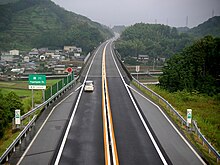
Kōchi is also serviced by the Kōchi interchange of the Kōchi Expressway which connects to the national expressway system.
Kōchi Ryōma Airport in nearby Nankoku serves Kōchi.
Tourism[]

Kōchi Castle still exists in its pre-restoration form, and is one of the main tourist attractions. Other places of interest in the city centre are the Obiyamachi (帯屋町) shopping arcade, the regular Sunday street markets which are close to a kilometre in length, and -bashi (はりまや橋), a bridge that featured in a famous Kōchi song about the forbidden love of a Buddhist priest.
The mountain Godaisan (五台山) holds a public park with views of the city, and is home to stop 31 on the Shikoku Pilgrimage, Chikurin-ji, as well as the Makino Botanical Garden. Temples 30 (Zenrakuji) and 33 (Sekkeiji) are also in the city. The Shinto Shrine Tosa jinja is located to the west.[6]
Off Museum Road (Kenritsu Bijutsukandori) is The Museum of Art, Kōchi, where the main collection is composed of expressionistic works related to Kōchi.[7] The Former Yamauchi Residence and Tosa Yamauchi Family Treasury and Archives are also to be found in the city.
At the mouth of Urado Bay, the remnants of Urado Castle (an earlier provincial seat) stand above Katsurahama (桂浜), a famous beach with an aquarium and statue of the Kōchi hero Sakamoto Ryōma. Nearby on the grounds is the Sakamoto Ryōma Memorial Museum.[8]
Culture[]
Events[]
Kōchi's most famous festival is the Yosakoi which is held in August. Teams of dancers dance to traditional and modern songs at various places around Kōchi. The total number of dancers is in the thousands.
Notable natives and residents[]
This section does not cite any sources. (September 2012) |

- Nakahama Manjirō (1827–1898) was one of the first Japanese people to visit the United States and an important translator during the opening of Japan.
- Okada Izō (1832–1865) was a samurai of the late Edo period, feared as one of the four most notable assassins of the Bakumatsu period.
- Sakamoto Ryōma (1836–1867) was a leader of the movement to overthrow the Tokugawa shogunate during the Bakumatsu period.
- Itagaki Taisuke (1837–1919) was a politician and leader of the Freedom and People's Rights Movement, which evolved into Japan's first political party.
- Tsutomu Seki (born 1930) is an astronomer who has discovered a number of comets and asteroids.
- Nobuo Uematsu (born 1959) is a video game composer, best known for scoring the majority of titles in the Final Fantasy series.
- Ryōko Hirosue (born 1980) is an actress and pop star, best known in the West for her roles in the Luc Besson-produced Wasabi and the Academy Award-winning Japanese film Departures.
- (born 1985) is a Kōchi-born former US college football player, and the starting kicker for Stanford University in 2006 and 2008.
- Sumi Shimamoto (born 1954) is an anime voice actress, best known for playing Kyoko Otonashi in Maison Ikkoku and Nausicaa in Nausicaa of the Valley of the Wind.
- Noa Tsurushima (born 2001) is a model and actress, best known for portraying Is and As in Kamen Rider Zero-One.
- Tomitaro Makino (1862–1957) was a pioneering botanist, sometimes referred to as the Father of Japanese Botany.
- Kusunose Kita (1836–1920) was an advocate for Women's rights in Japan, particularly in Kochi.
International relations[]
Sister cities[]
 Wuhu, Anhui, China
Wuhu, Anhui, China Surabaya, Indonesia[9]
Surabaya, Indonesia[9] Fresno, California, United States
Fresno, California, United States Kitami, Hokkaido, Japan
Kitami, Hokkaido, Japan
See also[]
References[]
- ^ Jump up to: a b c [1] Archived October 14, 2008, at the Wayback Machine
- ^ [2] Archived November 3, 2008, at the Wayback Machine
- ^ "21st Bomber Command Tactical Mission Report 247, 250, Ocr". Scribd.com. Retrieved 2013-12-09.
- ^ 気象庁 / 平年値(年・月ごとの値). Japan Meteorological Agency. Retrieved May 19, 2021.
- ^ "Official website of Kōchi City" (in Japanese). Japan: Kōchi City. Retrieved 2 May 2017.
- ^ Kōchi Prefectural Museum of History, map; retrieved 2011-08-09
- ^ [3] Archived January 25, 2008, at the Wayback Machine
- ^ "The Sakamoto Ryoma Memorial Museum". Kochi-bunkazaidan.or.jp. Archived from the original on 2014-05-23. Retrieved 2013-12-09.
- ^ "The Twin City". Surabaya.go.id. Archived from the original on 2013-12-14. Retrieved 2013-12-09.
External links[]
| Wikimedia Commons has media related to Kochi, Kochi. |
| Wikivoyage has a travel guide for Kōchi. |
- Kōchi City official website (in Japanese)
- Kōchi City official website (in English)
- Kōchi Visitors and Convention Association official website
- Yosakoi Festival in Kōchi CityNHK
 Geographic data related to Kōchi at OpenStreetMap
Geographic data related to Kōchi at OpenStreetMap
- Cities in Kōchi Prefecture
- Port settlements in Japan
- Populated coastal places in Japan
- Kōchi


